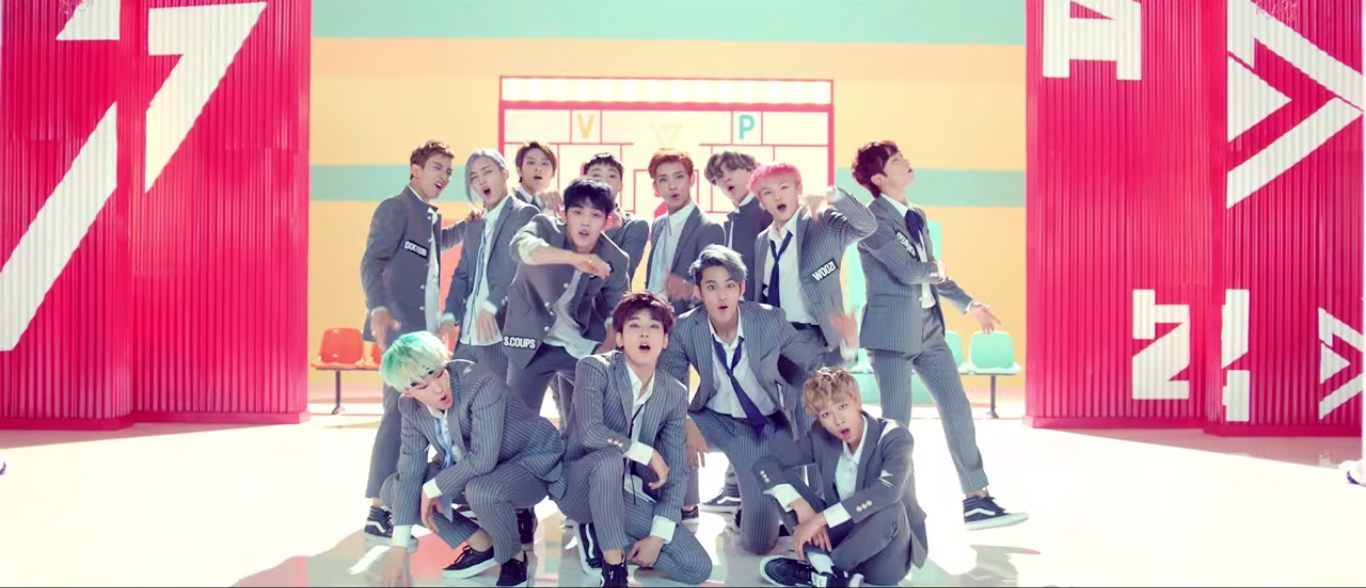Seventeen, Dancing, & East/West Ideals

One of the first things we notice when becoming K-pop fans is the influence of western pop. Musically, K-pop blends a whole host of genres otherwise unheard of in the east. These influences give K-pop an international edge allowing it to cater to a lot more fans than their Japanese and Chinese counterparts. This fusion usually comes in a musical and visual form. Hip-hop sounds and visuals are hugely prevalent in the last few years as K-pop senses the US market opening ever so slightly. Where it is not so obvious, however, is in performance. That’s where Pledis’ new boys Seventeen come in, they’ve got something new to show us all.
As we all know, dance is a big part of what makes K-pop special. But what is it that we love about it so much and why has dance not been westernized yet? For the former, I’d say it’s the collective commitment shown by nearly every group to being synchronized, which also hints at an answer to the latter question. That answer is a historic difference in core ideals between east and west.
In the west, capitalism and democracy took strong hold early on in society. In general, it promotes individual freedom and expression. The most powerful and renowned people in western societies are self-made entrepreneurs. In group dances this translates into simple routines with the more complex movements being executed by those who can do it while the rest stay by the wayside. Think of Beyoncé in Destiny’s Child or Nicole Scherzinger in Pussycat Dolls.
Also on KultScene: Seventeen’s ’17 Carat’ Album Review
In contrast, Confucianism and communism played a big part in building modern Asia, even in South Korea where it had little actual development. These systems promote the collective over the individual. Confucianism particularly promotes loyalty to seniority. This led to group dances where members work with each other, dance where each member is as good as the next. Nearly every K-pop group fits into this mold, especially any group with a large number of members. The only major exceptions would be YG’s big groups Big Bang and 2NE1. Those groups perform in a looser style allowing members with big personalities to shine, more similar to western musical acts.
So why hasn’t K-pop dance in general been affected in the same way as the music or clothing, emulating western music trends? The move into different musical styles does not actually reflect a great change of ideal within the K-pop community. Genres are merely changing ways of expressing songs that have been heard many times before. With dance, the human body is involved and usually in big numbers. It is a means of expressing societal norms. Changing this would be a fundamental change to Asian values.
This brings us to Seventeen. A group who may not be changing Asian values but are showing a new way of performing the old dance.
The choreography in Seventeen’s two singles up to now, “Adore U” and “Mansae,” has been delightfully inventive. They are pulling off a certain number of moves that I’ve never seen before in K-pop, and all with a youthful exuberance. From the human train in “Adore U” to the human crank in “Mansae,” there’s a lot to be impressed by Seventeen’s dances on a conceptual level. What makes these dances stand out though are the bits in between. When we’re watching great physical feats in the foreground, the background is always littered with other members having fun.
As a group consisting of thirteen members, naturally Seventeen are going to have a lot of big routines. Each of one of these dances are perfectly executed as they come across more like a small army than a boy band. With big K-pop groups big, synchronized routines are usually the extent of what can be delivered. Even dancing kings EXO who like to cut down members on stage at different times are always likely to stay in sync; the group always comes first. In contrast, Seventeen differentiate themselves in these moments. Each member is seemingly encouraged to bring as much personality to the stage as they can. Watch the beginning of “Adore U” where, in groups of three, the members play amongst themselves seemingly unaware that they are performing. In every break they have, members are always active, bouncing off each other, and generally being endearing. When watching them perform, even today, I still see details I hadn’t seen before. Like when, after collapsing to the floor in “Adore U”, S.Coups is revived and carried over to some other members all while the song has continued on another twenty seconds or so.
Also on KultScene: 5 Tear-Inducing K-Drama OSTs Pt. 2
These are only a fraction of the details that Seventeen put into their performance. They signal a kind of fusion of the ideals I talked about earlier. The group effort is still there and is more impressive than ever. They move between one whole group seamlessly into smaller groups all while maintaining perfect synchronicity. It’s the blending of their smaller moments that bring in the western ideas. There’s a great sense of personality within Seventeen. Each individual feels like a full character rather than a cog in a machine.
This doesn’t mean that K-pop is going to be completely infiltrated by western ideals in the near future, getting rid of all innately Asian elements. It’s an example of how pre-existing ideas from outside your regular environment can reinvigorate something well-trodden. Western ideas have always been in K-pop it was only a matter of time before someone exploited them for performance. Let’s be grateful that they have been exploited so brilliantly.
What do you think of Seventeen’s dances? Are there any other groups that do this? Share your thoughts in the comment section below and be sure to subscribe to the site and follow us on Facebook, Twitter, Instagram, andTumblr to keep up with all of our posts.
